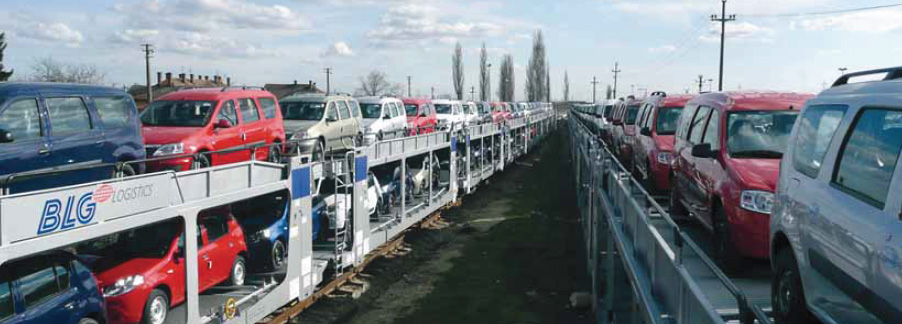
The integration of European rail freight and cross-border standardisation remains a distant dream. Countries have differing state and private provision, with consequences for logistics companies, writes Barry Cross.
The European Union has long had ambitions to move more freight by rail and has worked hard to deregulate the industry to boost competition. But to many major players in the vehicles logistics sector, there is still much to do.
Ingemar Abrahamsson of Volvo Logistics’ purchasing department says major problems remain, with different rail gauges and electrification voltages topping the list. “For quite some time, we have heard about the European Union’s wish to deregulate cargo traffic across Europe and make it easier for companies like ours to use rail. It’s a good idea, because it remains a highly bureaucratic exercise to send block trains between one country and another. Unfortunately, so far, we have yet to see any big moves in easing these restrictions. Now, it’s time for action not simply more words.”
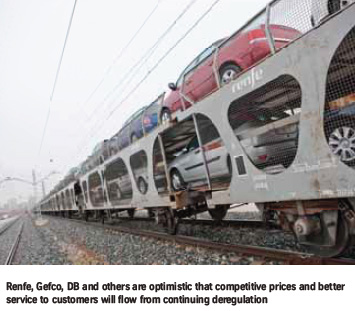 According to Gerald Binz, managing director of BLG AutoRail, access remains difficult, particularly in France, while deregulation in Germany has promoted competition and improved quality. Nevertheless, several successful private railway enterprises have been purchased by former state railways. The result has been that monopoly-like structures have once again come into being, thereby stifling competition. To make matters worse, the entire price advantage inherent in long hauls of finished vehicles can often be wiped out by the need to use a state railway company for haulage at the beginning and end of a journey. “Cross-border access simply has to be made easier and more integrated,” he argues.
According to Gerald Binz, managing director of BLG AutoRail, access remains difficult, particularly in France, while deregulation in Germany has promoted competition and improved quality. Nevertheless, several successful private railway enterprises have been purchased by former state railways. The result has been that monopoly-like structures have once again come into being, thereby stifling competition. To make matters worse, the entire price advantage inherent in long hauls of finished vehicles can often be wiped out by the need to use a state railway company for haulage at the beginning and end of a journey. “Cross-border access simply has to be made easier and more integrated,” he argues.
Axel Marshall, the head of the automotive division at DB Schenker Rail (DB SRA), agrees with Binz in that the EU’s “Liberalisation Index” shows member countries such as France, Spain and Hungary still have much to do, since their rail market is characterised by marginal competition, resulting in poor value for money. On the other hand, he acknowledges that, “Liberalisation opened the way for DB SRA to enhance its own service and boost quality, with subsidiaries and agencies now established in various countries.” The company’s Europe-wide Automotive RailNet connects manufacturers with markets all over Europe, with particular strengths in Germany, the UK, Spain, France and Poland. This position has been strengthened through the acquisition of Madrid-based logistics operator Transfesa.
“We are continuing to expand RailNet to link new automotive clusters and markets, with a special focus on the Eastern European market, especially Russia, which is showing strong development,” says Marshall, who insists that deregulation has eased the cross-border movement of vehicles. Logistics provider Gefco also sees national rail companies as continuing to play a dominant role in the European freight market, but other options are available, too. Antoine Redier, vice president of vehicle logistics, says that, “In France, we are now using an ‘alternative operator’, who is proving to be much more competitive and efficient than the historical operator.” But he is more pessimistic in respect of cross-border movements, where only certified multi-voltage locomotives with bilingual drivers can operate, noting that this type of service has inherent restrictions.
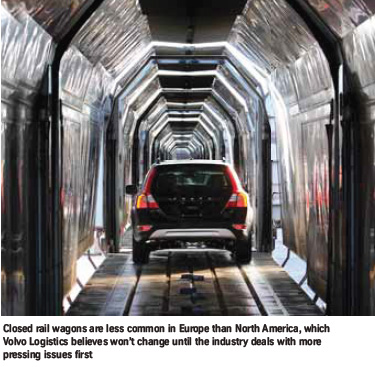
Irrespective of the current pan-European situation, Manuel Acero, managing director of the freight and logistics arm of Spanish National Railways (Renfe) is more upbeat, claiming that continuing deregulation will result in more competitive prices and a better service to customers. “Nowadays, a much wider range of options and prices are available to manufacturers and logistics providers,” he says.
Two major infrastructure upgrades–the opening of the Pertús Tunnel beneath the Pyrenees and the arrival of international gauge track linking France with Barcelona–will revamp cross-border possibilities, thanks to extra efficiency added to the logistics chain in terms of volume, journey times and overall sustainability. “Nevertheless, things do still remain to be done, particularly in respect of interoperability, if European rail is to be become truly agile,” says Manuel Acero.
To Russia and beyond
If interoperability within Europe remains a problem, moving trains even further east is a much bigger headache. Antoine Redier says that the proposed construction of a rail bridge over the Bosphorus may prove an incentive for some operators to provide services that link Turkey to Western Europe. He also remains upbeat about services to destinations in Russia, despite the need to tranship vehicles at the border because of the break in rail gauge.
“If the current level of imported volumes continues growing, it should be possible to launch a rail service connecting Western Europe and Russia,” he says. Gerald Binz nevertheless believes the break in rail gauge between Europe, Russia and Central Asia will remain a disincentive. Even running trains to Romania or Turkey creates problems, since onboard guards have to be provided to prevent vandalism or theft. To some extent, DB SRA is ahead of the game, with Axel Marshall pointing out that the company already operates daily finished vehicle shipments to Russia and these will be extended further east.
“Russia, especially, is a developing market with a lot of potential. The same is true for Turkey, where we already operate trains conveying car components and are currently checking the possibility of using these for finished vehicles, too. In addition, we have received our first customer requests to ship vehicles to Central Asia and plan to develop an appropriate train product.”
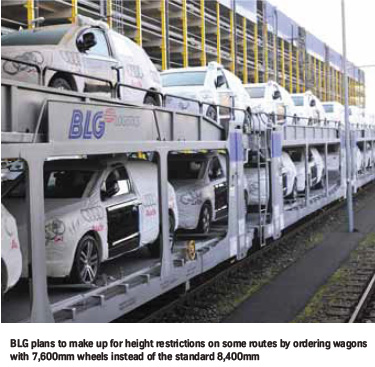
Distance myth dispelled
Within Europe, there has long been the belief that shipping finished vehicles by rail only makes financial sense on hauls over a certain distance. But is this true? In Sweden, Volvo Logistics currently manages two vehicle rail services. One rather minor one involves the movement of construction equipment vehicles, while the other encompasses the regular movement of cars between Gothenburg and Stockholm, a distance of 400km.
“However, it’s not a question of the distance involved,” stresses Ingemar Abrahamsson. “If there is a steady flow of vehicles between two sites–such is the case between Gothenburg and Stockholm–then rail can be competitive. We do always look at rail solutions, but only use them when it is beneficial for us. All too often, rail proves too inflexible.” Gefco transports more than 3,000 cars by rail per day. Antoine Redier says rail is seen as being competitive for distances over 500km. But in the case of highly concentrated volumes, it can make sense to use rail for shorter distances, although this is very much the exception.
But in Spain, Miguel Acero warns against seeing rail as only coming into its own on hauls of 350–400km plus. “For quite some time, we have been active in the Autometro company, which transports around 80,000 Seat vehicles from a factory in Martorell to the Port of Barcelona, a distance of only 30km. In such examples, rail is able to compete because it is handling large volumes,” he stresses.
As for BLG, whose aim is to transport approximately 320,000 vehicles by rail in 2011, “There is no minimum distance for transporting finished vehicles by rail, since rail offers advantages when large volumes, imbalanced traffic flows and shipments over long distances are involved,” says Binz. Says Axel Marshall, “Within Europe, we calculate that rail becomes economic on hauls of more than 400km. However, to and from ports, or if there are significant process advantages at the plant, shorter hauls are not that uncommon.”
What future for co-loading?
Few multi-client trains operate in Spain, although Miguel Acero thinks manufacturers and logistics companies should see this as a competitive option and as a way of reducing logistics costs. Co-loading vehicles from different plants with the same destination would undoubtedly bring benefits in terms of overall cost and transport time, he says. DB SRA only rarely consolidates output from different manufacturers, says Axel Marshall. He points out that it is more common to consolidate various volumes from different plants belonging to the same manufacturer for onward despatch. Nevertheless, he believes cost pressures on manufacturers will make concepts such as co-loading more common in the future. Gefco does not currently co-load at all. However, Antoine Redier stresses that it is almost a foregone conclusion that this practice will be adopted in the future.
Quizzed regarding a possible conflict of interest in doing this–since Gefco is owned by PSA–Antoine Redier points out that, even within PSA, the Peugeot and Citroen brands have their own sales targets, commercial events, model launch and so on, which he stresses is something that Gefco has always had to take into account.
“There is absolutely no conflict of interest either within PSA or with other manufacturers that we work for,” he says. BLG’s 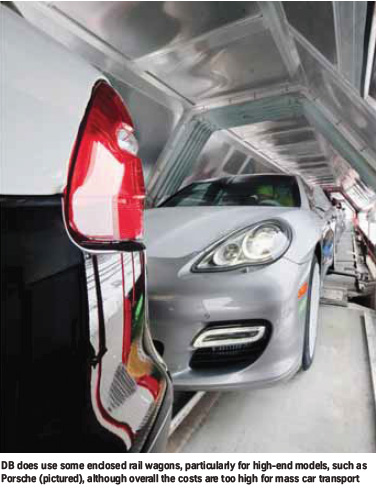 Binz sees potential in south-eastern Europe, where vehicles are dispatched long distances to the ports and major sales markets. Because sales are low in these countries, traffic flows are imbalanced, so that co-loading possibilities exist. Ingemar Abrahamsson says Volvo Logistics would like to use co-loading. However, to date, no major benefits from doing so have been identified, although the company remains optimistic for the future. In the end, the problem is one of logistics.
Binz sees potential in south-eastern Europe, where vehicles are dispatched long distances to the ports and major sales markets. Because sales are low in these countries, traffic flows are imbalanced, so that co-loading possibilities exist. Ingemar Abrahamsson says Volvo Logistics would like to use co-loading. However, to date, no major benefits from doing so have been identified, although the company remains optimistic for the future. In the end, the problem is one of logistics.
He adds that the company has a tender in the market at the moment for car distribution throughout Europe involving not just Volvo finished vehicles, but also those of other manufacturers. Rail solutions are being looked into, but so far they are not that promising, he says.
Loading gauge mitigates against tri-levels...
Tri-levels wagons–which are common for passenger cars in North America–also seem to be a non-starter, given the more restrictive loading gauge on most European railways, with those in France and Italy being a particular problem. Manuel Acero says that the industry cannot, however, remain complacent, even with such infrastructure limitations. “It is important that we have a flexible wagon fleet for finished vehicles. For example, 35% of the wagon fleet available to Renfe is sufficiently adaptable to accommodate vehicles of whatever size,” he says.
Gerald Binz takes a similar view, “In some cases, the lack of available height on some routes can only be compensated for by using smaller sets of wheels. In 2012, we will therefore place orders for such wagons, with 7,600mm wheels instead of the standard 8,400mm.”
DB, reveals Axel Marshall, has already examined the possibility of using tri-levels, but found that they were not compatible with the common European loading gauge. Even if a radical new tri-level design were made, he says it would not be financially viable.
...while closed wagons remain too expensive
The railways in North America have also eradicated most open rail transporter wagons for finished vehicles and reaped the financial benefits. So why hasn’t Europe followed suit? According to Axel Marshall, the manufacturing costs for enclosed wagons are much higher in comparison to the cost of open ones. These costs would then have to be passed onto customers in the form of higher prices. As a result, closed wagons are only affordable for those manufacturers shipping top-end models.
Gefco’s Redier also believes that the vast majority of finished vehicle transporter wagons used in Europe are likely to retain the open design into the foreseeable future. Gerald Binz claims that the loss ratio even using open rail transporters is better than that of road hauliers. Despite that, he confirms there are around 1,000 totally enclosed rail transporters in Europe, but the handling expenses involved in loading and unloading them are significantly higher than when using open wagons.
“Furthermore, paint quality has substantially improved in recent years. When nanotechnology is eventually brought in to paint cars, enclosed wagons will no longer be necessary at all.” For his part, Ingemar Abrahamsson senses that closed wagons have not become common in Europe simply because there are more pressing problems to solve first, namely providing a seamless and competitive cross-border service, despite the fact that European carriers are still suffering damage to vehicles in transit. “The US doesn’t have these problems, which is probably why they are ahead of us in rail wagon design,” he says.
Speed of response
Like their American counterparts, many European rail operators had to store wagons during the recent market downturn. Gefco, for example, withdrew more than 1,500 rail transporters because the volume of new cars being produced were so low. In contrast, in Sweden, Volvo Logistics reports that no wagons were stored.
But things are improving, prompting Axel Marshall to warn that something of a capacity crisis is about to hit the automotive logistics industry. Manufacturers forecast rising production over the next five years at a time when there is already a specialist wagon shortage. “The existing fleet of wagons that we have cannot cope with estimated demand,” he says.
To make matters worse, the number of equipment manufacturers in the market is quite small, with DB SRA faced with a lead time of 12–15 months to acquire additional stock. Gefco’s even larger operational fleet of 3,600 specialist wagons is also sometimes insufficient to meet demand, but this is not wholly a capacity problem, says Antoine Redier. “This is basically down to two factors: the poor efficiency of some rail operators and increasing demand,” he says, adding that the company is currently undertaking construction of new wagons, although lead times of around a year are not uncommon. However, manufacturing capacity is available once a design has been developed. Abrahamsson says Volvo Logistics’ experience is that it takes at least six months and possibly nearly a year to put new wagons into operation, and laments the fact that there are not that many players left in the market.
BLG AutoRail currently has 600 rail transporters for finished vehicles, rising to 800 by the end of the year and to 1,300 by 2012. Given regular maintenance, such equipment can remain in service for 35–40 years.
“Investment in railway wagons represent a sustainable strategy that leads to medium- and long-term success, he says, pointing out that even in the crisis, the company’s wagon fleet was used extensively and there was no need to take any of them out of service for reasons of downtime. However, only 20% of its wagons have a flexible upper deck capable of bi-level usage, which means there is a very high demand for these.
The need, or not, to increase the number of specialist rail wagons to transport finished vehicles depends on many factors, comments Manuel Acero. He mentions age, the emergence of taller vehicles and larger volumes among others. But he also points out that, even though the market might need new capacity, this won’t necessarily translate into an investment case. “However, once approval has been given, capacity to build wagons, both within Spain and in the rest of Europe, is sufficiently big enough to deal with any request that we make in this respect,” he says.


























![Global[1]](https://d3n5uof8vony13.cloudfront.net/Pictures/web/a/d/s/global1_726550.svgz)









